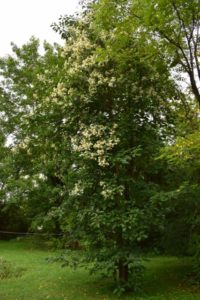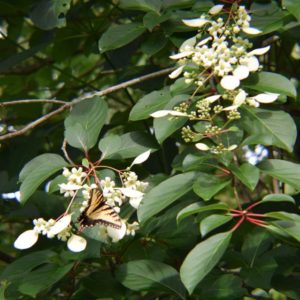Chinese Emmenopterys (Emmenopterys henryi) is rare in the wilds of China, and may be even rarer in cultivation (USDA hardiness zones 5-9). Discovered in 1907 by renowned botanist and plant hunter, Ernest H Wilson. He described it as: “…one of the most strikingly beautiful trees of Chinese forests.” It should grow 30 + feet tall, but can reach 80-100 feet in China.
Emmenopterys is widely distributed in south-central China, but is endangered due to agricultural expansion, logging, and poor forest regeneration. A member of the coffee family (Rubiaceae), the tree can grow to over 100 feet, although large specimens are extremely rare. Clusters of fragrant, creamy white, 1-inch, funnel-shaped flowers can be up to 10 inches across and are surrounded by large white “bracts,” similar to those seen on Japanese hydrangea vine (Schizophragma).
According to the China Plant Red Data Book, the species does not flower until 30 years of age and usually sets seed once every 2 to 4 years. A botanist in Johnson City, TN has nurtured a 15-year old specimen in his home garden. It has flowered a few times over the years, but never so fully. He reports that the flowers are very fragrant and are frequently visited by yellow swallowtail butterflies.
At Lewis Ginter Botanical Gardens in Richmond, VA, a nine-year old 25 foot tree was in full bloom on July 12, 2007. The funnel-shaped blooms have a unique form with each cluster surrounded by large white bracts; the blooms are accentuated by red petioles. Flowers are pollinated by a wide variety of insects including beetles and butterflies. Its seeds are winged and are distributed by wind.
At the Stephen F. Austin Gardens in Nacogdoches, TX, Dr. Dave Creech, Director of S.F.A. Gardens, reports that two plants were planted in 1998. “Our two trees have grown vigorously and are quite attractive in foliage. Our largest tree, the first to bloom, is now a full 25 feet tall and perhaps 20 feet wide at this writing (Nov 2009). While apparently quite healthy, the tree has not bloomed since the 2007 event.”
Dr. Creech describe the tree as having the clean, large opposite leaves with attractive red petioles. “Our two trees rest under a high canopy pine forest and in moist well drained soil. Both trees have grown vigorously and sport attractive ridged light-colored bark that is quite striking. White flowers are in panicles about 6 inches high and 8 inches wide with individual flowers less than an inch wide. The flowers are reminiscent of Pinckneya pubens.”
Propagation: Mist vegetative cuttings collected from late spring to early summer.
Source Credit: some information collected from Stephen A Austin Gardens website and Wikipedia



 Posted in
Posted in 
